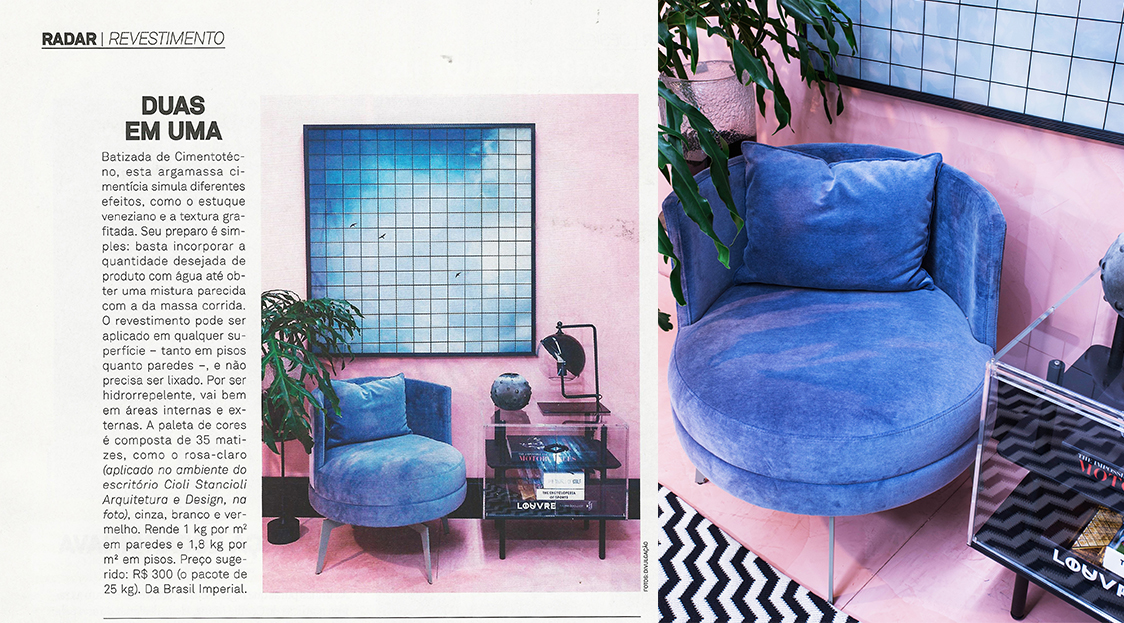REVISTA ARQUITETURA E CONSTRUÇÃO – CIOLI STANCIOLI

The February 2018 edition of architecture and construction brings an ambience designed by Studio Cioli Stancioli in one of Belo Horizonte’s most reputable furniture stores, Tom Sobre Tom. In this space, the highlight goes to the imperial cinema of Imperial Brazil (São Paulo | Belo Horizonte), which can be applied to both floors and walls. For being water repellent (Chemical, added to mortar, paints and varnishes with a function of protecting the surface of the camera. They are substances that stop water, preventing its passage, often used in the coating of parts and objects that should be kept second. ) eliminating or selecting a quantity of material, filling in infiltrations and isolating a sample of medium) goes well in indoor and outdoor areas, having a cost-effective 35-color core palette. @ciolistancioli @tomsobretom_ @ brasil.imperial.blocks @brasilimperial @sopisobh @reviewarchitectureconstruction @cunhaandreluizda @ euripedes.cunha
CEMENT TECNO OR TECNO CEMENT – The market today is always evolving and news is not lacking, especially with regard to finishing and coatings, and a recent fashion that gains a lot of space in construction and decoration and cement. technological or technocement. This coating offers purposes for the finishing of burnt cement, but with the ease of application of ready-made coatings, such as Marmorato, through the technology that accompanies the product.
Quotes from a product used for floors and walls in the Moorish and Byzantine times are very similar to the hydraulic tile manufacturing process. However, it is with the advent of the discovery of cement by the British chemist Joseph Aspdin in 1824 that the hydraulic tile found its final formulation, having undergone very little change since then. Hydraulic tile gained notoriety in the early twentieth century, especially in the Mediterranean regions, due to the movements of modernism in Spain and Art Nouveau in France, among others. With its great decorative possibility eventually won renowned architects and great artists, such as Cadafalch and Gaudi, thus living their time of greater splendor.
It was also in the early twentieth century that the tile landed in Brazil at the hands of Italian immigrants. At the time São Paulo lived a moment of great real estate expansion and the tile ended up being widely used in the cold areas of homes.
Even today floors made of hydraulic tiles can be seen in many of São Paulo’s historical buildings, such as the Campos Elíseos Palace, the Ipiranga Museum, the Marquesa de Santos House in the Páteo do Collegio, the Sion College, Mackenzie University, the Nossa Senhora do Brasil church, São Bento Monastery, as well as churches, shops and sidewalks.
Application
Sub-floor preparation:
As it is the tallest hydraulic tile than a conventional ceramic, this difference should be foreseen in the time to perform the subfloor regularization.
It is also recommended that any subfloor in direct contact with the soil be waterproofed, as there is a possibility that the soil moisture may be absorbed by the tile and thus end up with whitish stains on the resin layer.
Form of settlement:
Its settlement requires some special care, because it is a handcrafted material there is no standardization in the height of the piece, which has an average of 17 mm with a variation of approximately 1 mm. Therefore, this difference in settlement should be compensated by the increase / decrease of adhesive mortar on its base. Any excess mortar should be immediately wiped off the tile surface and on clear floors, it is recommended to use white adhesive mortar.
Dimension of ideal grout:
The hydraulic tile has in its tradition the laying with dry joint, but it is necessary any corrections with sandpaper on its sides. Narrow joint seating (from 1mm to 2mm) has a very positive result in its final appearance and does not create the need for part corrections. Only apply the grout after waterproofing the tile.
Note: Hydraulic tile can be laid with insignificant joints since, because they are made of cement mortar base and surface (unlike ceramic floors), they accompany the deformations of reinforced concrete structures due to climate change. , especially regarding the temperature.
Waterproofing and insulation:
For the waterproofing of the hydraulic tile, it is enough to apply concret surface acrylic resin in two coats and then two coats of Trendsetter acrylic wax.
Attention: It is very important to wait until the floor is completely dry before applying the waterproofing agent. This creates the need to isolate every area after it has been laid. Failure to comply with the drying period may result in the appearance of “whitish spots” which is a reaction formed by the rising moisture still present inside the tile in contact with the resin layer. Failure to insulate the newly laid area may result in stains from dirt that will be very difficult to leave as the hydraulic tile is a high porosity product.
Features:
Resistance
The wear resistance of the tile is extremely high and is even recommended for public sidewalks.
Non-slip, Rusticatto and Riscatto lines also have non-slip features.
Absorption
Hydraulic tile is an extremely porous product, so its absorption is very high to any type of material, such as water, dirt, sauces, among others, so it is essential to waterproof the floor after its placement.
Maintenance and cleaning:
◊ Try to keep your floor always waxed even if it is already waterproofed with acrylic resin;
◊ Never use acid-based products for tile cleaning;
◊ On waterproofed tiles, use only mild soap and water for periodic cleaning;
◊ In cases of dirt where the tile has not been properly waterproofed, use the Limpbrim degreaser in higher concentration but it is possible that a total cleaning may not be achieved, so remember:
Always waterproof your tile!